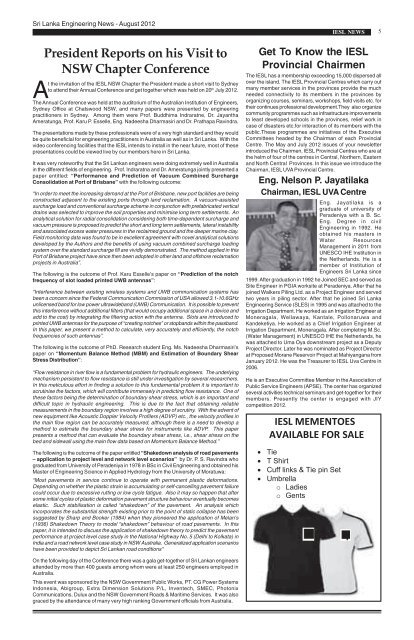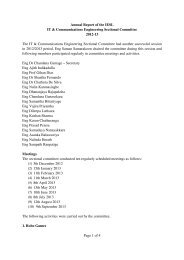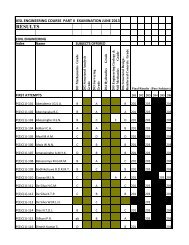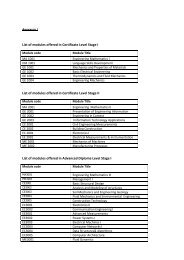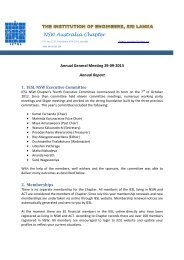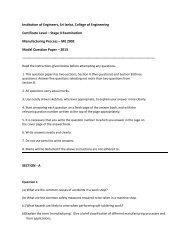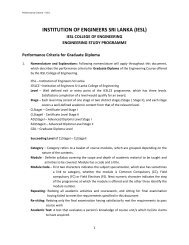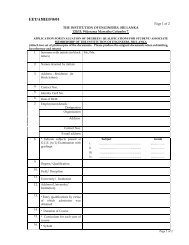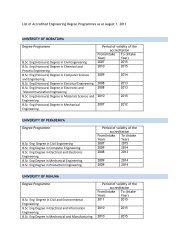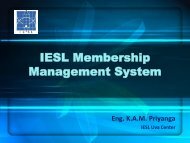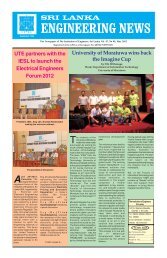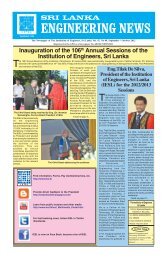Download - The Institution of Engineers, Sri Lanka
Download - The Institution of Engineers, Sri Lanka
Download - The Institution of Engineers, Sri Lanka
You also want an ePaper? Increase the reach of your titles
YUMPU automatically turns print PDFs into web optimized ePapers that Google loves.
<strong>Sri</strong> <strong>Lanka</strong> Engineering News - August 2012<br />
President Reports on his Visit to<br />
NSW Chapter Conference<br />
At the invitation <strong>of</strong> the IESL NSW Chapter the President made a short visit to Sydney<br />
to attend their Annual Conference and get together which was held on 20 th July 2012.<br />
<strong>The</strong> Annual Conference was held at the auditorium <strong>of</strong> the Australian <strong>Institution</strong> <strong>of</strong> <strong>Engineers</strong>,<br />
Sydney Office at Chatswood NSW, and many papers were presented by engineering<br />
practitioners in Sydney. Among them were Pr<strong>of</strong>. Buddhima Indraratne, Dr. Jayantha<br />
Ameratunga, Pr<strong>of</strong>. Karu P. Esselle, Eng. Nadeesha Dharmasiri and Dr. Prathapa Ravindra.<br />
<strong>The</strong> presentations made by these pr<strong>of</strong>essionals were <strong>of</strong> a very high standard and they would<br />
be quite beneficial for engineering practitioners in Australia as well as in <strong>Sri</strong> <strong>Lanka</strong>. With the<br />
video conferencing facilities that the IESL intends to install in the near future, most <strong>of</strong> these<br />
presentations could be viewed live by our members here in <strong>Sri</strong> <strong>Lanka</strong>.<br />
It was very noteworthy that the <strong>Sri</strong> <strong>Lanka</strong>n engineers were doing extremely well in Australia<br />
in the different fields <strong>of</strong> engineering. Pr<strong>of</strong>. Indraratna and Dr. Ameratunga jointly presented a<br />
paper entitled: “Performance and Prediction <strong>of</strong> Vacuum Combined Surcharge<br />
Consolidation at Port <strong>of</strong> Brisbane” with the following outcome:<br />
“In order to meet the increasing demand at the Port <strong>of</strong> Brisbane, new port facilities are being<br />
constructed adjacent to the existing ports through land reclamation. A vacuum-assisted<br />
surcharge load and conventional surcharge scheme in conjunction with prefabricated vertical<br />
drains was selected to improve the soil properties and minimise long term settlements. An<br />
analytical solution for radial consolidation considering both time-dependent surcharge and<br />
vacuum pressure is proposed to predict the short and long term settlements, lateral instability<br />
and associated excess water pressures in the reclaimed ground and the deeper marine clay.<br />
Field monitoring data was found to be in excellent agreement with novel analytical solutions<br />
developed by the Authors and the benefits <strong>of</strong> using vacuum combined surcharge loading<br />
system over the standard surcharge fill are vividly demonstrated. <strong>The</strong> method applied in this<br />
Port <strong>of</strong> Brisbane project have since then been adopted in other land and <strong>of</strong>fshore reclamation<br />
projects in Australia”.<br />
<strong>The</strong> following is the outcome <strong>of</strong> Pr<strong>of</strong>. Karu Esselle’s paper on “Prediction <strong>of</strong> the notch<br />
frequency <strong>of</strong> slot loaded printed UWB antennas”:<br />
“Interference between existing wireless systems and UWB communication systems has<br />
been a concern since the Federal Communication Commission <strong>of</strong> USA allowed 3.1-10.6GHz<br />
unlicensed band for low power ultrawideband (UWB) Communication. It is possible to prevent<br />
this interference without additional filters (that would occupy additional space in a device and<br />
add to the cost) by integrating the filtering action with the antenna. Slots are introduced to<br />
printed UWB antennas for the purpose <strong>of</strong> “creating notches” or stopbands within the passband.<br />
In this paper, we present a method to calculate, very accurately and efficiently, the notch<br />
frequencies <strong>of</strong> such antennas”.<br />
<strong>The</strong> following is the outcome <strong>of</strong> PhD. Research student Eng. Ms. Nadeesha Dharmasiri’s<br />
paper on “Momentum Balance Method (MBM) and Estimation <strong>of</strong> Boundary Shear<br />
Stress Distribution”:<br />
“Flow resistance in river flow is a fundamental problem for hydraulic engineers. <strong>The</strong> underlying<br />
mechanism persistent to flow resistance is still under investigation by several researchers.<br />
In this meticulous effort in finding a solution to this fundamental problem it is important to<br />
scrutinise the factors, which will contribute immensely in predicting flow resistance. One <strong>of</strong><br />
these factors being the determination <strong>of</strong> boundary shear stress, which is an important and<br />
difficult topic in hydraulic engineering. This is due to the fact that obtaining reliable<br />
measurements in the boundary region involves a high degree <strong>of</strong> scrutiny. With the advent <strong>of</strong><br />
new equipment like Acoustic Doppler Velocity Pr<strong>of</strong>ilers (ADVP) etc., the velocity pr<strong>of</strong>iles in<br />
the main flow region can be accurately measured, although there is a need to develop a<br />
method to estimate the boundary shear stress for instruments like ADVP. This paper<br />
presents a method that can evaluate the boundary shear stress, i.e., shear stress on the<br />
bed and sidewall using the main flow data based on Momentum Balance Method.”<br />
<strong>The</strong> following is the outcome <strong>of</strong> the paper entitled “Shakedown analysis <strong>of</strong> road pavements<br />
– application to project level and network level scenarios” by Dr. P. S. Ravindra who<br />
graduated from University <strong>of</strong> Peradeniya in 1978 in BSc in Civil Engineering and obtained his<br />
Master <strong>of</strong> Engineering Science in Applied Hydrology from the University <strong>of</strong> Moratuwa:<br />
“Most pavements in service continue to operate with permanent plastic deformations.<br />
Depending on whether the plastic strain is accumulating or self-cancelling pavement failure<br />
could occur due to excessive rutting or low cycle fatigue. Also it may so happen that after<br />
some initial cycles <strong>of</strong> plastic deformation pavement structure behaviour eventually becomes<br />
elastic. Such stabilisation is called “shakedown” <strong>of</strong> the pavement. An analysis which<br />
incorporates the substantial strength existing prior to the point <strong>of</strong> static collapse has been<br />
suggested by Sharp and Booker (1984) when they pioneered the application <strong>of</strong> Melan’s<br />
(1936) Shakedown <strong>The</strong>ory to model “shakedown” behaviour <strong>of</strong> road pavements. In this<br />
paper, it is intended to discuss the application <strong>of</strong> shakedown theory to predict the pavement<br />
performance at project level case study in the National Highway No. 5 (Delhi to Kolkata) in<br />
India and a road network level case study in NSW Australia. Generalized application scenarios<br />
have been provided to depict <strong>Sri</strong> <strong>Lanka</strong>n road conditions”<br />
On the following day <strong>of</strong> the Conference there was a gala get-together <strong>of</strong> <strong>Sri</strong> <strong>Lanka</strong>n engineers<br />
attended by more than 400 guests among whom were at least 250 engineers employed in<br />
Australia.<br />
This event was sponsored by the NSW Government Public Works, PT. CG Power Systems<br />
Indonesia, Abigroup, Extra Dimension Solutions P/L, Inventech, SMEC, Photonix<br />
Communications, Dulux and the NSW Government Roads & Maritime Services. It was also<br />
graced by the attendance <strong>of</strong> many very high ranking Government <strong>of</strong>ficials from Australia.<br />
IESL NEWS<br />
Get To Know the IESL<br />
Provincial Chairmen<br />
<strong>The</strong> IESL has a membership exceeding 15,000 dispersed all<br />
over the island. <strong>The</strong> IESL Provincial Centres which carry out<br />
many member services in the provinces provide the much<br />
needed connectivity to its members in the provinces by<br />
organizing courses, seminars, workshops, field visits etc. for<br />
their continues pr<strong>of</strong>essional development.<strong>The</strong>y also organize<br />
community programmes such as infrastructure improvements<br />
to least developed schools in the provinces, relief work in<br />
case <strong>of</strong> disasters etc.for interaction <strong>of</strong> its members with the<br />
public.<strong>The</strong>se programmes are initiatives <strong>of</strong> the Executive<br />
Committees headed by the Chairman <strong>of</strong> each Provincial<br />
Centre. <strong>The</strong> May and July 2012 issues <strong>of</strong> your newsletter<br />
introduced the Chairmen, IESL Provincial Centres who are at<br />
the helm <strong>of</strong> four <strong>of</strong> the centres in Central, Northern, Eastern<br />
and North Central Provinces. In this issue we introduce the<br />
Chairman, IESL UVA Provincial Centre.<br />
Eng. Nelson P. Jayatilaka<br />
Chairman, IESL UVA Centre<br />
Eng. Jayatilaka is a<br />
graduate <strong>of</strong> university <strong>of</strong><br />
Peradeniya with a B. Sc.<br />
Eng. Degree in civil<br />
Engineering in 1992. He<br />
obtained his masters in<br />
Water Resources<br />
Management in 2011 from<br />
UNESCO IHE <strong>Institution</strong> in<br />
the Netherlands. He is a<br />
member <strong>of</strong> <strong>Institution</strong> <strong>of</strong><br />
<strong>Engineers</strong> <strong>Sri</strong> <strong>Lanka</strong> since<br />
1999. After graduation in 1992 he Joined SEC and served as<br />
Site Engineer in PGIA worksite at Peradeniya. After that he<br />
joined Walkers Piling Ltd. as a Project Engineer and served<br />
two years in piling sector. After that he joined <strong>Sri</strong> <strong>Lanka</strong><br />
Engineering Service (SLES) in 1995 and was attached to the<br />
Irrigation Department. He worked as an Irrigation Engineer at<br />
Moneragala, Wellawaya, Kantale, Pollonaruwa and<br />
Kandeketiya. He worked as a Chief Irrigation Engineer at<br />
Irrigation Department, Moneragala. After completing M.Sc.<br />
(Water Management) in UNESCO IHE the Netherlands, he<br />
was attached to Uma Oya downstream project as a Deputy<br />
Project Director. Later he was nominated as Project Director<br />
at Proposed Morane Reservoir Project at Mahiyangana from<br />
January 2012. He was the Treasurer to IESL Uva Centre in<br />
2006.<br />
He is an Executive Committee Member in the Association <strong>of</strong><br />
Public Service <strong>Engineers</strong> (APSE). <strong>The</strong> center has organized<br />
several activities technical seminars and get-together for their<br />
members. Presently the center is engaged with JIY<br />
competition 2012.<br />
5


